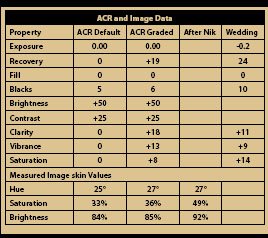articles/Software/grisnik-page2
Getting to grips with Nik's Software - part 2 of 1 2 3 4
by Mike McNamee Published 01/12/2009

The result is characterised by a lowered saturation and an enhanced edge effect, a little like over-sharpening. Sofie Louca has created the same effect from scratch in the previous feature, so you have a number of choices.
Nik Filters have been earning professional photographers additional income for some time. The software is capable, in good hands, of adding a signature style to an image or even an entire album. There is a difference between images that you might create for a competition and those which the bride's mother will approve of - we add that as a health warning at the start of this feature. Time and time again photographers have offered images with 'advanced' techniques, styles and features, only to discover that their clients have rather conservative tastes! It is against this background that Aled has been using Nik filters to enhance his portraiture and wedding photography, but in quite a restrained way for much of the time.

The Nik Color Efex filters provide 52 basic effects but the actual number is boosted by, for example, Monday Morning containing an additional five variants. With 52 filters and over 250 effects found in Color Efex Pro 3.0 you can perform high quality retouching, colour correction and endless creative enhancements to your photographs. This is actually a bit of a problem; the enthusiast has time to try many options out, the busy professional can barely afford that time, particularly at the height of the season. Aled, for example, has typically only been using Nik Software for between two and 10 images per wedding, in a wedding shoot running up to 800 images. This is some way from the enthusiasts' more scatter-gun approach. With a long background in print laboratory management and an almost unequalled experience of colour grading at speed, Aled's light-box in either Lightroom or Adobe Bridge is a joy to behold, a seamless array of equally graded thumbnails! For this reason we were anxious to learn and measure how his grading varied between an 'album ready' image and a 'ready for Nik' image. To this end we had Aled provide both his work files and the original RAW captures.
One of the gratifying things about the data analysis is that Aled has, completely independently, arrived at the same numerical skin-tone data, and position on the graph, as we found ourselves when analysing Martin Sellar's data from several years ago. Martin, with an experience in colour printing to match Aled's, had shown Caucasian brides a number of pictures and arrived at an area in the Lab graph where the favoured skin tones resided. In essence this is slightly more saturated and slightly more yellow than average Caucasian skin (see the graph).
Please Note:
There is more than one page for this Article.
You are currently on page 2
- Getting to grips with Nik's Software page 1
- Getting to grips with Nik's Software page 2
- Getting to grips with Nik's Software page 3
- Getting to grips with Nik's Software page 4
1st Published 01/12/2009
last update 21/07/2022 08:46:24
More Software Articles
There are 6 days to get ready for The Society of Photographers Convention and Trade Show at The Novotel London West, Hammersmith ...
which starts on Wednesday 14th January 2026










